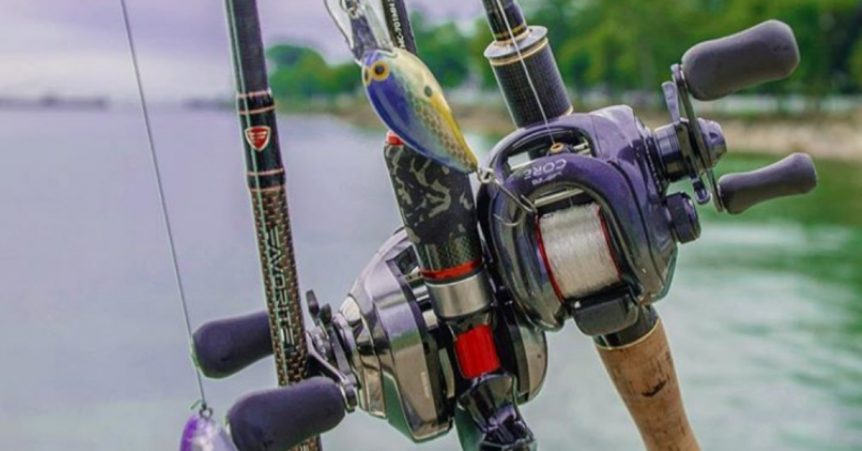Your Guide To Buying A Baitcaster Reel
Selecting your first baitcaster can be a daunting task as there are so many products and price points on the market today. Sometime during the initiation process of bass fishing, anglers take steps that elevate them from a beginner to the more advanced status of their sport. One crucial step in this process is learning how to master a baitcast reel.
Spinning and spin-cast reels can adequately handle some bass fishing techniques (especially light-line presentations), but the durable and dependable baitcast reel is the ultimate choice for serious anglers when they encounter bass in the rivers and lakes throughout the country. Whether fishing standing timber, weeds, rocks, boat docks or brush piles, a bass fisherman depends on heavy line and a baitcast reel to winch bass out of some tight places.
Purchasing Your First Baitcaster
So any beginning bass anglers who want to consistently catch more fish must make the baitcast reel one of their key tools of the trade. Since reel manufacturers have made baitcasters highly specialized lately, novices have a more difficult choice when buying their first baitcast reel. There are a few guidelines beginners can follow to help them pick a baitcaster that fits their needs though.
Setting A Budget
The first step you need to take when choosing a baitcast reel is considering the price of the various models. You should set in your mind what your budget is going to be and what you are willing to spend on a reel. Then look at getting the most reel for that dollar amount. You should avoid buying cheaper reels because those models usually aren’t equipped with good, lasting features.
Understanding Pricing
If you buy the cheapest reel you can find, you will usually be frustrated with its performance or it won’t last long. The amount of usage can determine how much you should spend on your first baitcaster. If you are going to fish more than 35 days a year you should look at spending about $100 for a baitcast reel because it will give you high performance with a good number of ball bearings and it will last you a long time if you take care of it. You should buy a reel with as many ball bearings as possible because more ball bearings ensure great durability and longevity of the reel and enhances its performance.
All reels now have some sort of magnetic cast control which will help you avoid the frustration of constant backlashes. Baitcast reels with magnetic cast controls feature magnets that put resistance on the spool as it turns and serve as fine-tuning mechanisms in conjunction with the reel’s main cast control. If the magnets and cast control are working properly, you can cast the reel without applying any thumb pressure to the spool and have the lure hit the water without any backlash.
Baitcasters Magnetic Breaking
Despite the cast controls and magnetic braking systems on today’s baitcasters, you still need to learn the basics of casting a baitcast reel, even if you buy a high-dollar model. Don’t expect the reel to do all the work for you. Casting a baitcaster is still a matter of the skill level of the angler to understand the principle of a baitcast reel in that the spool revolves. It’s still up to you to control the spool’s speed with your thumb.
Your first baitcaster should also have a reliable drag system. You want a drag that keeps the pressure on bass without line slippage but will also allow a surging bass to pull line smoothly off the spool to prevent it from breaking your line.
You should also consider purchasing a baitcast reel designed for multiple tasks rather than a model made for special duties such as deep cranking or high-speed retrieves. All of today’s reels are designed to do more than one thing simply because they have the cast control features with the magnetics and flipping features that allow you to disengage the spool, pitch the lure out and still have control with your thumb over how far the lure goes.
Get A Reel That Can Do It All
Your first baitcaster should be a multipurpose reel in the mid-price range with a gear ratio between 6.2:1 to 7.0:1. Most of these reels will have about the same line capacity of 110 to 120 yards in the 10- to 14-pound test range.
A reel in the mid-speed gear ratio range will handle most bass fishing applications because it allows you to adjust the speed of your retrieve easier than low- or high-speed reels. If you are fishing a buzz bait or Rat-L-Trap, you can crank a 6.2:1 reel faster and still get good performance. If you are slow rolling a spinnerbait or fishing a deep-diving crankbait you can still wind it slow enough that it’s not going to overwork the lure. If you buy a baitcast reel on either side of the spectrum on gear ratios it will be hard to work a higher speed reel slowly or a low-speed reel faster.







